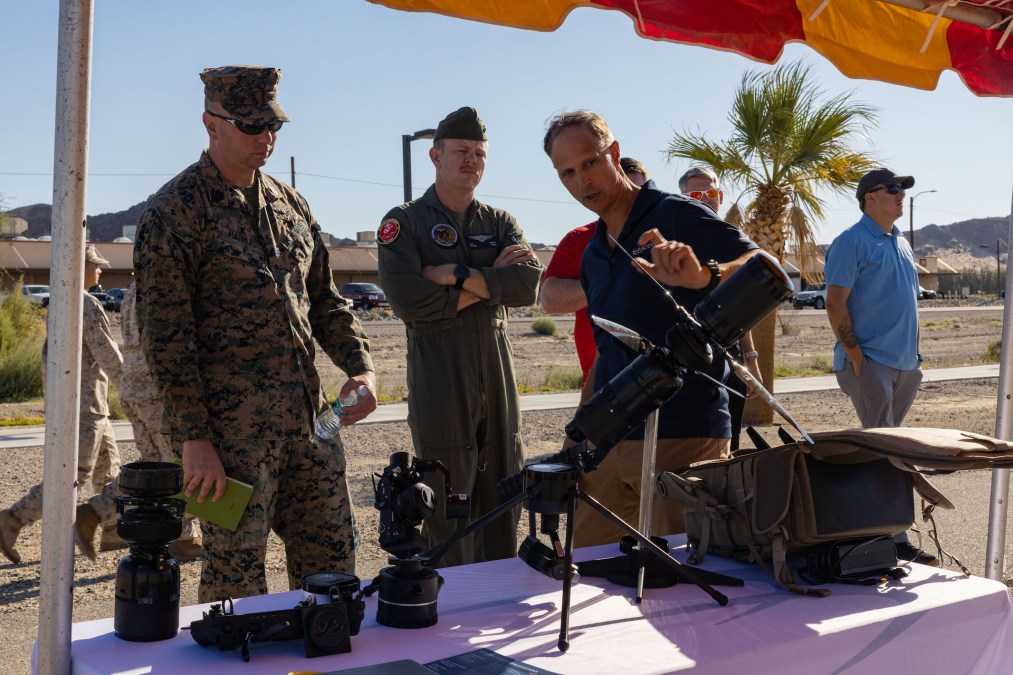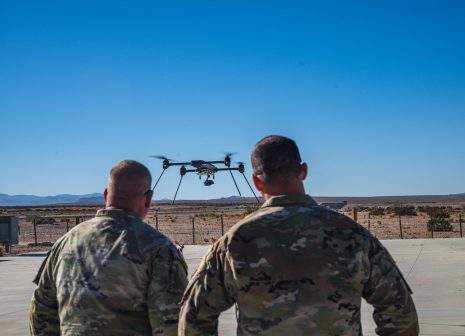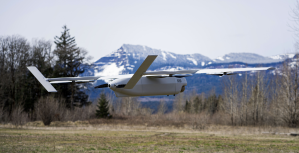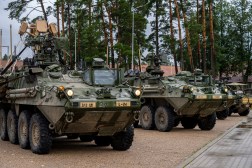What’s unique about DIU’s new prize challenge to extend the Pentagon’s drone supply

The Defense Innovation Unit is moving fast to expand the military’s arsenal of commercial drones and access to connected digital capabilities, via a new prize opportunity that’s heavily inspired by real-world combat observations from the ongoing war in Ukraine.
Some U.S. service members will inform the process and help decide what technologies are ultimately cleared for wider use in DIU’s new Blue UAS Refresh Challenge, according to the official overseeing it.
“One of the things about the upcoming prize challenge — it’s different. Actual operators and end users are going to be the ones who determine the platforms, companies and capabilities that are selected to actually go to the flight event. Then, they’re going to be the ones doing the actual testing, as folks from operational units giving feedback within a rubric that we develop to ensure that it’s a fair and competitive process,” DIU’s lead for Blue UAS Trent Emeneker told DefenseScoop in a recent interview. “So they pick what they want — not what a program office or some level of bureaucracy eight layers above them thinks is the right idea.”
Early roots of this drone-enabling initiative stem back to 2018 and the launch of the U.S. Army’s Short Range Reconnaissance program of record. But in 2020, DIU initiated the broader “Blue sUAS” effort after Congress prohibited the Defense Department from buying or deploying certain drone components from Chinese manufacturers, and U.S. government personnel identified a dire need for an accelerated process to onboard regulation-compliant American makers of small uncrewed aerial systems.
While that iteration focused on rapidly onboarding approved suppliers for smaller drones, in this now-unfolding Blue UAS Refresh Challenge the Pentagon’s recently elevated innovation arm aims to identify first-person-view (FPV), Group 1, Group 2 and Group 3 platforms — as well as components, capabilities and software for associated UAS systems — and expedite their use by the military.
Emeneker, a Marine Corps reservist and DIU contractor, recently briefed DefenseScoop on the hub’s maturing vision for the overarching Blue UAS effort and the latest updates on this new prize challenge.
“If we don’t get this right and we have to send folks into combat, they’re going to pay the price. So it’s unacceptable for us to fail. We haven’t succeeded yet. Blue UAS is not a success, yet. It’s not a failure. We’re doing better than the alternative but we have to do better, because the 19-year-old kid [in the military] deserves better. That’s what drives us — because they need the very best that we can give them,” he said.
‘Software defines success’
Broadly, Blue UAS encompasses DIU’s evolving approach and associated projects to vet and scale commercially produced drone technologies at an accelerated pace, and then deliver them into the hands of DOD users to deploy for in-demand military applications.
“There are three ways that folks can buy UAS platforms: program of record, exception to policy, or off the ‘Blue List.’ It does unlock sales there also. And this is where I would say, whether we’ve intended it or not, Blue UAS has become a seal of approval in the marketplace,” Emeneker said.
Through two previous Blue UAS-aligned opportunities that DIU hosted since 2020, approved companies made the unit’s “cleared list,” which enables them to be deemed compliant by congressional standards and more swiftly available for DOD customers to buy and operate.
“Traditionally, when we’ve added platforms to the Blue UAS List, we’ve done them in big chunks. We had what we called at the time ‘Blue 1.0,’ where we added five, and then ‘Blue 2.0’ added another eight. Since then, we’ve had services and program offices sponsor a few more platforms that they wanted added. But this market moves so fast that if you add something and two years later you still have it and they haven’t updated the platforms and the software and the capabilities, it’s out of date. So we have to move faster,” Emeneker said.
DIU and its National Security Innovation Network (NSIN) program office team, which is known for putting on modernization-pushing prize challenges, are designing this challenge to culminate at a demonstration day on Nov. 4 at Marine Corps Air Ground Combat Center in California.
Proposals from companies that aim to participate are due to DIU by Aug. 19, and finalists are expected to be announced in September.
Ultimately, multiple “winners” could be chosen to then be eligible for inclusion on the cleared Blue UAS List for flying platforms — or the new Blue UAS Framework List, which Emeneker said his team has been “significantly” rolling out over the past six months.
“In this space, it’s not the flying platform that makes you successful. That’s the core, but it’s the components, the sensors, the capabilities and the software that go on it that give you the tools that you actually need out on the battlefield. So ‘framework’ is everything else. It’s radios, it’s cameras, it’s software,” Emeneker said. “And part of this effort is to significantly expand our framework to induce modularity, to get all our end users to plug-and-play and solve their problems with what they need, not to have them locked into a very rigid configuration.”
DOD classifies UAS platforms based on their size and capacity, with the smallest ones in Group 1 up to the largest in Group 5. Unlike prior Blue UAS endeavors that only included small drones, the Defense Innovation Unit opted to expand this prize challenge to notably include FPV, Group 1, Group 2 and Group 3 systems.
According to Emeneker, that “is a direct result of both operator and user feedback, and our observations of the real world.”
“Those platforms — from FPV to Group 3 — it is very clear that on the modern battlefield you have to have them,” he said.
A variety of other learnings from contemporary conflicts influenced the structure and vision for DIU’s latest challenge.
“We communicate with Ukrainian partners, with Ukrainian companies. But you can just get on [social media] and see what’s going on. The point that we’re also trying to drive at with Blue UAS is that this is an area where software defines success,” Emeneker said. “You have to have a baseline hardware capability, but the software that goes on it, along with the enabling components, is what’s going to allow you to succeed.”
Right now, he noted, DOD spends “an average of 12 months or more to approve a software update when a vendor rolls it out,” before it can be applied to the end product. It currently takes about 45 days at DIU to approve software updates associated with Blue UAS, which in Emeneker’s view “sounds better in comparison but is not acceptable.”
“If a vendor’s not rolling out a software update every two months, they’re probably not delivering the capabilities that we want,” he added.
Speed and optionality
“The other piece is tying in user feedback to the firm, to the company. So this is a lesson that we see very clearly in Ukraine. End users at the front lines know what’s going on. They see the problems and they’re fighting in real time. They send those technical problems back, and that’s where the software engineers or the company comes out with a patch, or a new update, or a new piece of hardware to meet that emerging threat, and then they pour it directly back in. Their timelines are extremely fast,” Emeneker noted.
The Marine reservist pointed to examples provided “from Ukrainian friends,” such as some who said they were able to identify a software vulnerability and patch it within 96 hours.
“That was the fastest timeframe they could give, but it illustrates the speed that you can work at and what we need to be pushing for,” he said.
Informed on those and other lessons stemming from ongoing military missions, DIU is partnering with multiple operational units to get input during the selection process from personnel who might have requirements to deploy such capabilities down the line.
“We’ve opened it up across the services, and at this point we have confirmed participants from the Marine Corps, from the Army, from [Special Operations Command], from the Navy and multiple [special operations forces units] intended to be represented. I have everyone from a brand new, 19-year-old operator, to a 30-something who has been doing this for 15 years within SOCOM and is extremely experienced — and the range in between. Because what one needs is not what the other needs. And we want to make sure that we’re getting feedback and addressing all the different capabilities and use points,” Emeneker explained.
After the demonstrations in November, the Blue UAS Refresh Challenge will likely result in some proposed drones and technologies eventually being eligible for inclusion on DIU’s Blue UAS or Blue UAS Framework lists.
Emeneker noted there would also be possible follow-on opportunities such as other transaction agreements and cooperative research-and-development agreements.
“It’s not something DIU gets in the market of doing — we don’t have contracts where we buy drones and then give them out. That’s not our business. But if a service wants to say, ‘I like that Platform X or Software Y’ they can put that on contract via an OTA and get deliveries going,” he noted. “The benefit to that is the timeline is as fast as they want to move, because an OTA can be on contract in 60 days or less. Compare that to [a Federal Acquisition Regulation-based] acquisitions process of 18 months, maybe two-and-a-half years, it just depends. So, we unlock speed and optionality,” he said.
Emeneker and his colleagues at DIU and NSIN recognize that they probably won’t get everything right and as envisioned in this new and unique prize challenge.
“Some of the things we pick, the end user’s not going to want — and in a market-driven economy, which is what we want to go to, that’s fine. Those will be platforms that when we look at it next year, it looks like they failed, they’re going to come off the list. And we’re going to put something else on that we think meets the needs better,” he told DefenseScoop.






